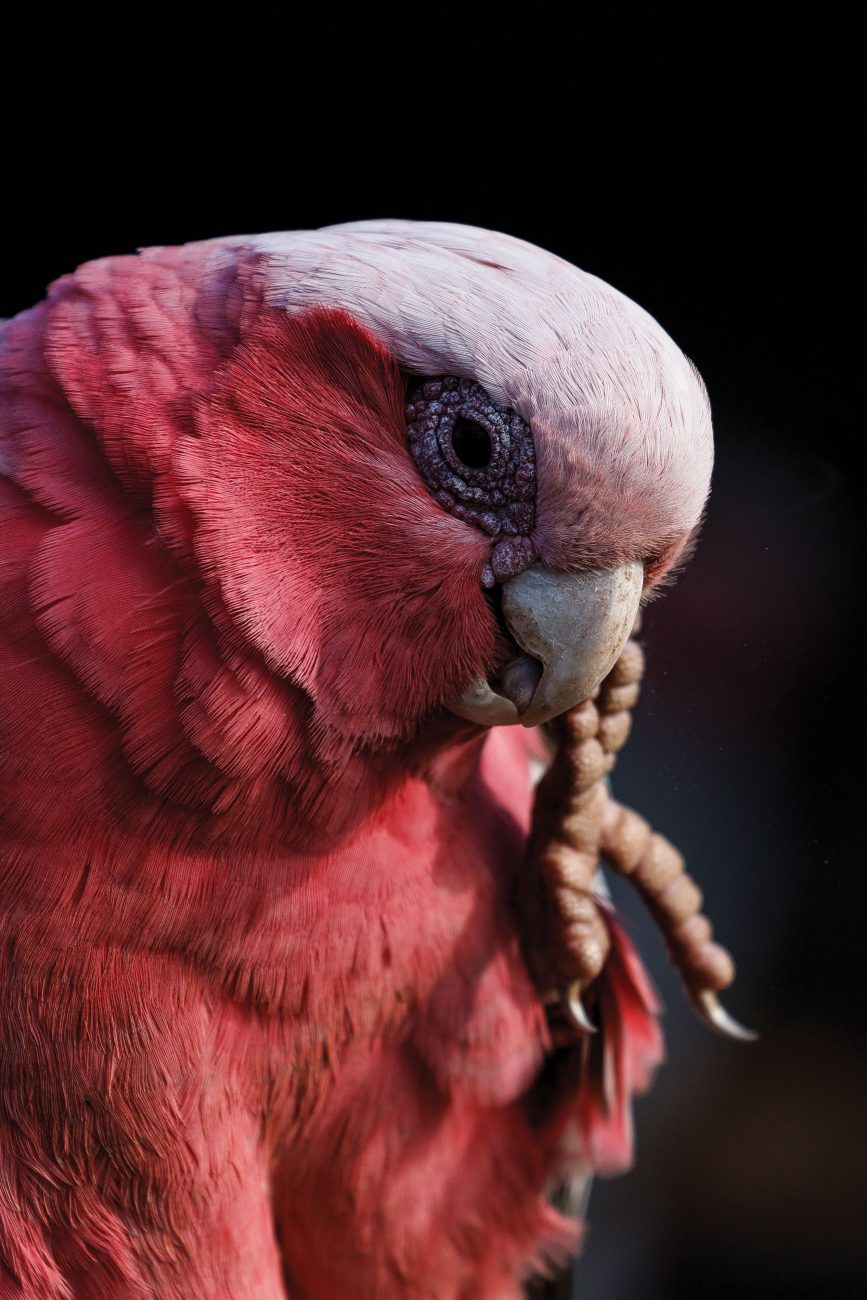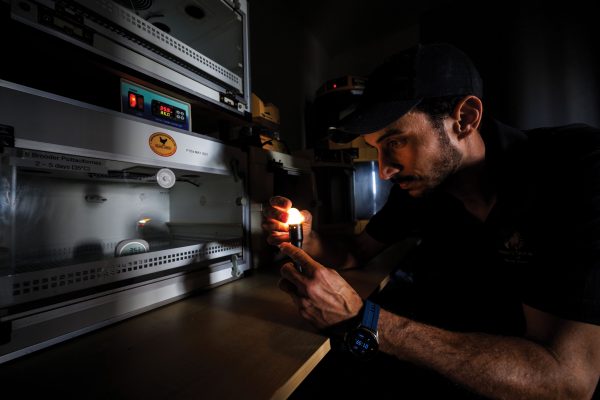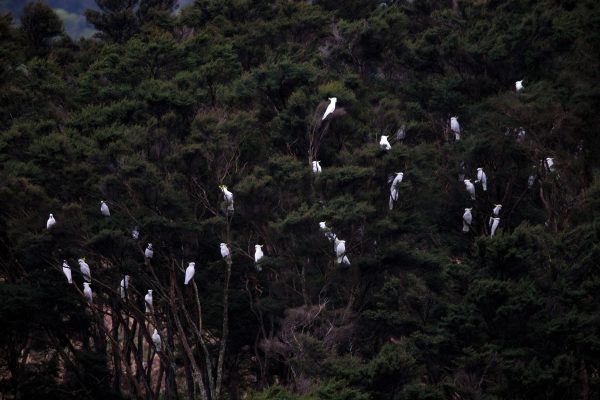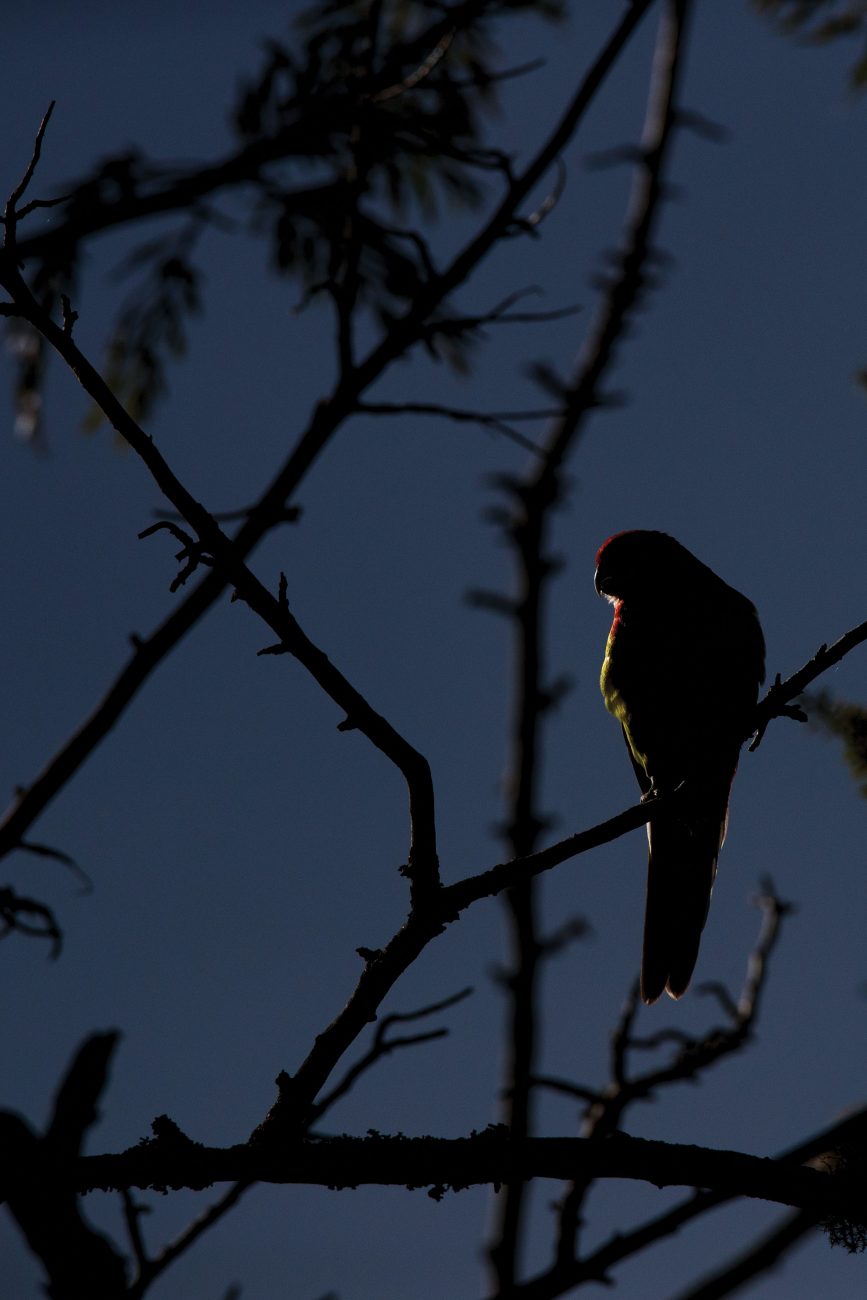
The big bird ban
Six parrot species are set to be banned in the Auckland region due to the dangers they pose to native wildlife. Is this fair?
The bird watches me with an inquisitive eye. She’s huge, nearly a metre from top-of-head to tail-tip. Her curved hook of a beak looks thick and strong enough to break my finger, so I refrain from stroking her plumage—bright blue and buttercup yellow with an emerald crown and a hint of zebra stripes around her eye. She stretches her wings, fluttering them awkwardly. I’m standing in an aviary with seven blue-and-yellow macaws, just a few months old. They screech and flap and cling to the cage mesh and screech some more.
Despite the cacophony and commotion, my host, Leno Dima, is unruffled. He gently scritches the feathers on the back of one of the macaws’ heads, and the parrot closes her eyes in bliss.
“I love these birds,” he sighs. Originally from Brazil, where he trained as a parrot biologist, Dima came to New Zealand to learn English. “Now I’m living in my paradise, working with birds.”

Dima is the aviary manager for a private collection of parrots, pheasants and other birds near Whangārei. Every day, he cares for hundreds of parrots, preparing their meals and cleaning their cages. When breeding season starts, he will carefully collect the birds’ eggs and place them in incubators. Then, he becomes a full-time parrot parent, feeding tiny pink featherless chicks every two hours—day and night—for eight or so months. It’s a gruelling job, but for Dima, it’s worth it.
“They’re so smart and so comical,” he says, stroking the long tailfeathers of one of the birds. She emits an ear-shattering caw.
Here, in a sprawling network of aviaries, a discordant orchestra of squawking, screeching, croaking, whistling, and the odd “Hello, my darling!” rings out. Bright colours flash behind wire. There are yellow-headed Amazon parrots, renowned for their mimicry; gang-gang cockatoos, small ashen parrots with fluffy crests and a call that sounds like a rusty gate hinge; conures the colour of a tropical cocktail; shrewd African grey parrots that regard me from lofty perches; squeaking galahs; elegant scarlet macaws; even a couple of kākāriki.

The flock belongs to David Graham, who has long been captivated by the beauty of birds. First, he says, it was “funky, true-to-type chickens”, but then he “quickly got into pheasants”. He proudly points out his Himalayan monal, which he calls “a walking pāua shell”. The pheasants eventually led him to parrots—an interest first spurred when he lived in Thailand as a child and dabbled in breeding budgies.
“It’s a combination of their spectacular colouration, speaking ability, and capacity to learn tricks,” he says. His favourite is the double yellow-headed Amazon parrot, but he thinks African greys come out on top in terms of intelligence and speech. “The stuff they pick up is just phenomenal,” he says. “They’re especially good at metallic and robotic sounds, but they’re also more shy and reserved. Amazons are a close second in terms of mimicry, but they have more spunk, more character and more melody.”
Graham breeds and sells parrots, but he’s quick to point out that the business is self-sustaining, rather than profit-driven. For him, it’s a labour of love—all for the love of birds.
“Breeding parrots is a long game, not a fast game. You can’t just stick them together like dogs; they need to wine and dine before they’ll pair-bond.”

But if Graham lived in Auckland, he wouldn’t be allowed to breed, sell or distribute three parrot species—rainbow lorikeets, monk parakeets, and Indian ringneck parrots—from September 2022 onwards. From 2025, eastern rosellas, galahs and sulphur-crested cockatoos will be off the table, too. (Graham breeds the latter two species.) All six species are listed on Auckland Council’s Regional Pest Management Plan 2020–2030.
It’s the first such biosecurity measure to come into effect in New Zealand. Some see this bird ban as drastic and even unwarranted, but for ecologists, it’s an essential step towards protecting our own distinctive flora and fauna.
[Chapter Break]
When I arrive at Ark in the Park in west Auckland, the first wildlife I see is a raucous flock of sulphur-crested cockatoos. They’re off in the distance, a flurry of white against the lush bush, their shrieks echoing across the valley.
“I came here to work with our amazing native species, like kōkako,” says park manager Samantha Lincoln. “But all I hear and see all day are those damn cockatoos.”
This flock has roosted in kauri in the Waitākere Ranges for more than 100 years, with sightings reported from the early 1900s. It’s thought they established from escaped captive birds—although there may be the odd genuine vagrant blown across the Tasman from Australia.
The Waitākere birds aren’t the only cockatoos in the Auckland region. There are around 150 galahs—pink and grey cockatoos with crests that look more like a flat-top hairdo than a feathery Mohawk—that travel between the Hunua Ranges and the inner islands of the Hauraki Gulf. This small flock is thought to be the result of cage escapes.
More bands of sulphur-crested cockatoos are scattered across New Zealand on Banks Peninsula, around Whanganui, and in the Waikato, including a flock found on farmland near Miranda, where their noise once drove resident Moira Soppet from her home.
“It was so deafening—just the high-pitched squawking,” says Soppet. “It seemed to me that they kept flying around and around. For our own mental health, we went out for the day. We just couldn’t stand the noise.”
Sulphur-crested cockatoos and galahs have been able to make a home here in New Zealand thanks to land clearing, which has resulted in tracts of open farmland adjacent to woodland, which more closely matches their natural habitat across the ditch.

Then, there are eastern rosellas, a type of parakeet you might see in your backyard if you live in the North Island or in Dunedin. They’re rainbows in flight, a blaze of red and lime and blue, and less boisterous than their cockatoo cousins, with bell-like chimes and chattering calls.
Eastern rosellas, originally from south-east Australia, were introduced to the wild here a few times across the 20th century, likely through a combination of cage escapes and deliberate releases. The rosella takeover began in 1910 in Dunedin, when a vessel carrying “a small shipment” of rosellas was denied entry at the port. The birds were released at sea instead, just off Otago Heads, and thus seeded the Dunedin flock. Populations in Auckland first appeared in the 1920s, and in Wellington in the 1960s.
Since then, the eastern rosella population has been growing and spreading, and ecologists are concerned about the potential impacts on native species.
“Parrots are a risk,” says ecologist Margaret Stanley. “We know they’re clever, adaptable, very flexible in their habits, and highly competitive.”
For example, eastern rosellas could out-compete native kākāriki for nest sites, as both species like cosy tree hollows. “Eastern rosellas will often lay the eggs on top of other birds’ eggs, or lay their nests on top,” says Stanley, an associate professor at the University of Auckland.
There’s also the threat of viral beak and feather disease. It can be common in captive populations, and we don’t really know how some of our natives—like kea and kākāpō—would fare in an outbreak. In 2009, beak and feather disease was detected in kākāriki on Te Hauturu-o-Toi/Little Barrier Island. They’d caught a strain similar to the strains circulating in eastern rosellas.
But Stanley is also worried about how rosellas are affecting our perception of birdlife, after she visited a school where all the kids were keen to build a bird feeder to attract “that very colourful New Zealand native parrot”. It was an eastern rosella—not a native at all.
Even Graham, with his deep appreciation for parrot colour palettes, says he would much rather see kākāriki flying around than eastern rosellas.
[Chapter Break]
With eastern rosellas already so well established in New Zealand, and sulphur-crested cockatoos present for more than a century, it may seem a bit surprising to see them included in Auckland’s bird ban. But Imogen Bassett, biosecurity principal advisor at Auckland Council, says it’s about turning off the tap.
“In the same way, we don’t want people growing privet hedges, even though privet is widespread as a weed,” she says. “It just adds more pressure, locally, to that issue.”


As for the other three parrots—monk parakeets, Indian ringnecks, and rainbow lorikeets—Bassett points to their “clear track record of invasiveness overseas”. For example, visit Hyde Park in London and the first bird you’re likely to encounter is a ringneck parrot. These tropical parrots have unexpectedly thrived in the big grey city, exploding in recent years to a population estimated at around 8600 breeding pairs. Head to Madrid or Barcelona and you’ll find thousands of monk parakeets far from their South American home range. Feral populations of monk parakeets have cropped up across Europe and North America, where they are known for building huge communal nests out of sticks, weighing up to a tonne. “They like to build them on powerlines and cell-phone towers and things like that,” says Stanley, “and that can lead to significant problems with power outages and fires—real public safety and cost concerns.”
The bird ban comes from a basic tenet in biosecurity: prevention is better than cure.
“This is the equivalent of going back in time and preventing possums from being released, as opposed to managing them,” says Bassett. “We see this as an opportunity to learn from what’s happened in our own history, and also what we see overseas, and prevent us from adding another suite of invasive species to New Zealand.”
[Chapter Break]
Catching a parrot is tricky—they’re clever and crafty. So when Art Polkanov was tasked with catching more than 200 of them, he knew he had a challenge ahead. Polkanov, a zoologist, was hired by the Department of Conservation (DOC) in 2000, joining Paul Keeling in efforts to eradicate rainbow lorikeets from northern Auckland.
The rainbow lorikeets hadn’t ended up in the wild by accident. A local resident, Rex Gilfillan, had released them in the early- to mid-1990s, allegedly because he believed New Zealand’s native birds were drab and dull—he wanted a splash of colour.
According to Polkanov, Gilfillan had two houses on his North Shore property and one of them had been converted into an aviary in its entirety. After a flock of free-flying rainbow lorikeets nearly destroyed a nearby Norfolk pine, a concerned neighbour raised the alarm.
Scientists and officials were worried that rainbow lorikeets would compete with native birds for food and nest sites—pushing out even the famously bolshie tūī. The parakeets could easily make the quick flight across to Te Hauturu-o-Toi/Little Barrier Island and spread avian diseases among the endangered native parrots that live there. Plus, there were economic concerns, with potential impacts on fruit growers. In 1999, rainbow lorikeets were declared an Unwanted Organism. (Gilfillan was charged with breaching
the Wildlife Act by releasing 50 lorikeets, but the case was thrown out on a technicality.)
By the time Polkanov and Keeling got under way, there were around 250 to 300 rainbow lorikeets loose across Auckland. “Gilfillan admitted in an international parrot magazine published in Canada that there were 250 rainbow lorikeets in the wild,” says Polkanov. “They had started breeding by that time, because we caught quite a few young ones.”
Polkanov had permission to shoot the lorikeets, but chose to capture them alive instead. “If it were a snake, or a spider, people would be against them immediately. But these were fluffy birds with nice colours… pretty awful voices, but they’re smart and fun to watch,” he says.
The duo found a “good-sized flock” at Red Beach on the Whangaparāoa Peninsula, and got started with step one of their operation: watch and learn. They set up a cage trap with a side door open, but the birds wouldn’t go in the cage; they simply sat on top of it.

Step two: find something to lure the lorikeets into the cage. It turns out Polly doesn’t want a cracker—Polly wants a tipple. “All smart birds love sweetened alcohol, so the idea was to get them addicted, then to trap them,” says Polkanov. But getting birds drunk posed a bit of an ethical issue, so instead they turned to “Judas” lorikeets—captive birds that lure in their compatriots, like sirens seducing sailors.
Step three: Polkanov and Keeling constructed a large cage with a spring-loaded sliding door on top. Then, they placed a smaller cage inside, containing two Judas lorikeets. The contraption was placed on the roof of a Red Beach house next to a flowering banksia tree—an extra attractant for nectar-loving lorikeets.
The wild birds would hear the calls of their caged friends and pop down for a look-see, entering the top of the cage. Then Polkanov would pull a string, snapping the cage door shut. Using this method, they could catch up to a dozen curious lorikeets in one go.
After eight weeks, Polkanov and Keeling had caught the 30 or so lorikeets at Red Beach, then turned their attention to the rest of Auckland. It took two years to capture around 200 birds, followed by two years of monitoring to make sure they’d got them all. Some of the recaptured birds were sold to recoup a fraction of the eradication costs—which totalled $245,000 (equivalent to more than $400,000 today).
While Polkanov and Keeling perfected the art of ensnaring rainbow lorikeets, our techniques for catching bird pests in general are well behind where we’re at with rats and stoats. For birds in ones and twos, picking them off with a rifle is doable—but for larger flocks, like the cockatoos in the Waitākeres, birds quickly become shy of gun-toting humans.
Polkanov’s experience helped to keep other invasive bird species in check. Stanley says Polkanov is “singlehandedly responsible for stopping many bird incursions in their tracks”. On average, he handled 30 reports of exotic birds in Auckland every year, and lent his expertise to rangers across New Zealand—from Dunedin to Rotorua—to deal with unwanted flocks, many of them rainbow lorikeets.

For his last operation, Polkanov removed a pair of red-vented bulbuls that had built a nest and laid eggs at Ports of Auckland. Red-vented bulbuls are one of the world’s 100 most invasive species, but there isn’t a self-sustaining population here in New Zealand—yet. It’s likely this pair hitched a ride into Auckland on a ship. But Polkanov tells me he had to take annual leave to eliminate the bulbuls, after a restructure in 2018 saw DOC shift its focus away from biosecurity. Polkanov resigned soon after.
Now, it’s unclear who is dealing with unwanted birds that turn up in New Zealand’s biggest city. In 2019, when another flock of rainbow lorikeets was illegally released in Titirangi, a contractor had to be brought in to capture them—and even then, action was taken only after several concerned residents complained to their local MP.
Of course, deliberately released parrots aren’t the only exotic birds that end up in our fields, forests and backyards. Pets go missing all the time.
[Chapter Break]
Margaret Stanley was overseeing a research project on backyard birdfeeders when she got the idea. From time to time, exotic birds such as canaries would appear for a snack of seeds. She wondered: just how many of these escaped pets were out there?
Stanley and her team began regularly monitoring Trade Me and the Pets on the Net website for lost-bird listings. They gathered up all the details into a spreadsheet: type of bird, number of birds, place lost and name (Buddy, Comet and Peanut were among the names of the lost). They collected data over three and a half years; 92 per cent of the birds reported as lost were parrots.
Stanley’s team put these numbers into a statistical model to figure out how many birds were out there, based on different species’ lifespans, and they found that during any one month, there are around 491 pet birds on the loose in Auckland.
The model also calculated the likelihood of a male bird encountering his female equivalent in Auckland. The probabilities the model spat out surprised Stanley: for both Alexandrine and ringneck parrots, there was 100 per cent probability that a male and a female were hanging around the same area of Auckland at any one time. “The Alexandrine parrots weren’t on our radar,” says Stanley, “but we’ve since read they can hybridise with ringnecks, too.”
Some other species with high chances of male-female pairings aren’t so much of a worry, because their survival is limited by environmental factors. For example, cockatiels and budgies are outback desert birds, and can’t breed in wild conditions in New Zealand.
“There are certainly budgies out there, and cockatiels out there,” says Stanley. “While they may not be breeding, they may be living to a ripe old age,” she says, emphasising that non-breeding birds could still spread disease. She shows me pictures of a budgie visiting the supplementary feeders intended for hihi/stitchbirds on pest-free Tiritiri Mātangi Island.

But for those species that are suited to our environment, successful establishment becomes more likely if you release the birds repeatedly, and in more places. Stanley says we have good evidence for this from New Zealand’s meticulous Acclimatisation Society records: birds with lots of release records, in lots of places, are more likely to be still living with us now.
Reducing this volume of lost parrots to reduce the chance of sustained populations is the reasoning behind the Auckland Council’s move to phase out certain species, says Bassett.
“If we can drive down the accidental release, through a combination of regulation and increased awareness of responsible pet ownership, then I think we stand a really good chance of being able to prevent these issues happening,” she says.
But these moves have faced fierce opposition from a small group of passionate parrot owners and enthusiasts, led by the Parrot Society of New Zealand.
[Chapter Break]
It’s a sunny Saturday morning in late July, and the annual sale of the Parrot Society at Māngere Memorial Hall is buzzing. There are people of all ages milling around tables stacked with books and birdseed—and, of course, birds. There are whistling king parrots in festive green and red garb, pretty princess parrots with blush pink faces, and ruffian lorikeets hanging upside-down, shrieking. A young girl wanders around with a sunshine-yellow conure clambering over her shoulders, pirate-style.
Hayden van Hooff, president of the Parrot Society, tells me there are usually more birds on offer, but COVID delays have meant this year’s sale is only capturing the tail end of the breeding season.
Van Hooff’s first parrot was a cockatiel, Jake, given to him by his grandfather when he was just five years old. “Jake loved my mother, but he hated me,” says van Hooff. That didn’t stop him. By the time he was 13 years old, van Hooff had about “40 or 50 aviaries” filled with lots of lorikeets of all kinds—rainbow, scaly-breasted, red-collared, musk. Then, he began to branch out into African grey and Amazon parrots.
“I was always an outcast as a kid, and coming home to my parrots has always been a highlight,” he says. “I don’t know where I would be without my parrots.”
Nowadays, van Hooff has “streamlined” his collection: he has just one bird, an Amazon parrot that he calls Baby. “She doesn’t shut up! She’s in my office every day, and every time I’m on the phone she’s all I hear. She just talks and talks and talks,” he says.
At the sale, van Hooff runs a raffle and auction, offering parrot paintings and parrot food and a knitted parrot jumper. It’s all to raise money to pay off gargantuan legal fees accrued by the society in its quest to halt the Auckland Council’s bird ban. Members of the society breed and trade all six species facing the ban; lorikeets and sulphur-crested cockatoos are here for sale today.
Former president Mary-Lee Sloan says members only “caught wind of the ban through a Facebook post”. By then, the consultation period had passed, and the plan was signed off. (Bassett says the council did send correspondence to the email address listed on the Parrot Society’s website, but the society says it hasn’t found any record of an email from the council.)


This meant that legal action was the only avenue left for the society, and it took the council to the High Court. A few days before the case was set to begin, the council offered a reprieve until 2025 for three species—galahs, sulphur-crested cockatoos, and eastern rosellas—but not before the society had sunk $190,000 into its legal battle.
Van Hooff says the society offered alternatives to the council, such as a register for breeders, or paying for a licence, as dog owners do. This would have funded inspections of parrot keepers’ set-ups to ensure they were secure. “There are one hundred ways we could have done it without an outright ban,” says van Hooff. “We would have been more than happy to work with the council on these issues.”
Aviculture is dying in New Zealand, van Hooff tells me. But it has contributed fundamentally to our own birdlife, with bird breeders imparting their knowledge on incubation and hand-rearing techniques to DOC, underpinning conservation work such as kākāpō breeding programmes.
“There’s just this massive untapped resource of people with decades of experience… It’s a real shame. If they were to put together the right regulations and work with breeders, I know of at least 20 or 30 who would have no problem breeding pure red-crowned, yellow-crowned, orange-fronted, Antipodes Island parakeets, kea, kākā,” says van Hooff, “and they would do it all free of change. For the love of birds.”
He points out that even if parrots do escape, “people get them back. They’re a bird of value.” (The society is firmly against deliberate releases. According to van Hooff, “We don’t condone people releasing parrots into the wild. It is not okay. It’s not fair on the bird, either.”)
As the society packs down trestle tables and stacks chairs, Sloan shows me her most precious cargo: a portable incubator, holding parrot chicks. There is a red-tailed black cockatoo, its feathers just starting to come in, in the classic “feed me” posture all baby birds adopt. There is a tiny fuzzy eclectus parrot chick, its eyes still closed. Sloan has to feed the chicks every two hours, which means toting them with her to this sale.
For Sloan and van Hooff, and others in the aviculture community, birds are companions, an obsession, and part of their livelihoods. “Not everybody likes fish and cats and dogs,” says Sloan. “This is our love, our passion. To watch your birds and interact with them—it takes the stress away.”
















